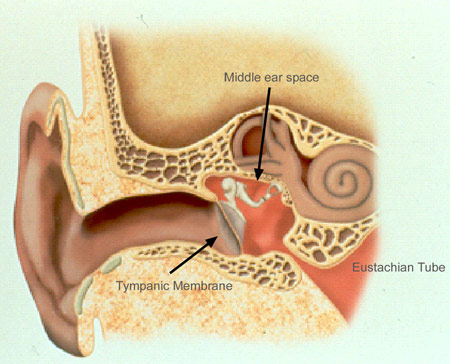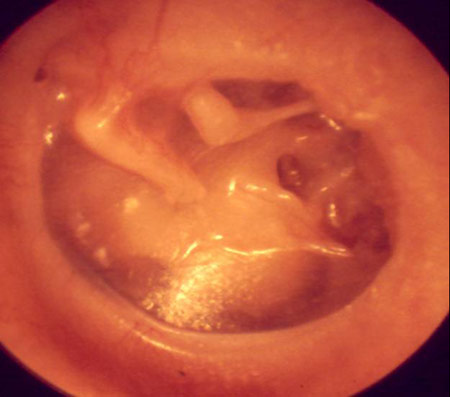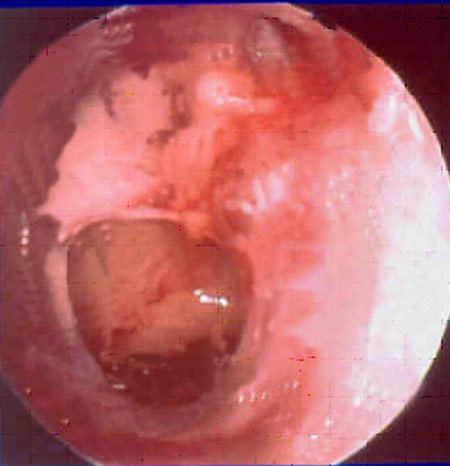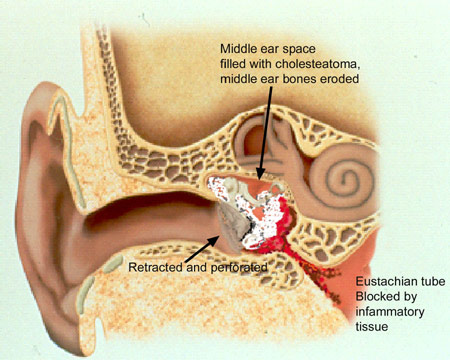Chronic Ear Infections
The middle ear and its structures
The middle ear is a hollow chamber in the bone of the skull. It is separated from the outside world by a thin membrane about half-an-inch in diameter, the eardrum. The middle ear area is lined by the same kind of mucous membrane that lines nose and mouth. It is connected to the back of the nose, just above the soft upper portion of the mouth, by a narrow passage called the eustachian tube.
The eustachian tube lies closed until the swallowing movement pulls it open and allows fresh air to enter the middle ear. The fresh air is needed to replace oxygen that has been absorbed by the middle ear lining. The fresh air equalizes the middle ear pressure with the air pressure outside the head. Some people hear this burst of fresh air as a pop or click.
Suspended within the middle ear is a chain of three small bones, the ossicles, which conduct sound vibrations from the eardrum across the middle ear into the fluid-filled inner ear. Inside the inner ear these vibrations are converted to nerve signals that are carried by the auditory nerve to the brain.
The mastoid bone is an extension of the air space of the middle ear. It is made up of small interconnected air spaces similar to a honeycomb. Its function is not clear, but it is often involved in chronic ear infections. Within it lie the structures of the inner ear responsible for balance and facial expression.

Anatomy of Middle Ear
Chronic otitis media (COM) is the term used to describe a variety of signs, symptoms, and physical findings that result from the long term damage to the middle ear by infection an inflammation. This includes the following:
- Severe retraction or perforation of the eardrum (a hole in the eardrum)
- Scarring or erosion of the small, sound conducting bones of the middle ear
- Chronic or recurring drainage from the ear
- Inflammation causing erosion of the bony cover or the facial nerve, balance canals, or cochlea (hearing organ)
- Erosion of the bony borders of the middle ear or mastoid resulting in infection spreading to the meninges (the coverings of the brain) or brain
- Presence of cholesteatoma
- Persistence of fluid behind an intact eardrum

Retracted ear drum

Perforated ear drum
If the Eustachian tube becomes blocked by swelling or congestion in the nose and throat, by swelling of the mucous membrane in the middle ear, or by swelling of the mucous membrane of the Eustachian tube itself, the air pressure in the middle ear cannot equalize properly. A negative pressure develops, and if the obstruction is prolonged, fluid may be drawn into the air space of the middle ear from the mucosa. This may occur with a cold or flu virus and is a common cause of ear infections in children (serous otitis media). Serous otitis media usually resolves without treatment, but may require a course of antibiotics or steroids. It is a common reason for placement of tubes in children and adults.
If the eustachian tube blockage persists, chronic changes in the tissue of the middle ear begin to occur. First the mucous secretions become thicker, and therefore less likely to drain. Then the membranes themselves begin to thicken and become inflamed. The defense mechanisms of the Eustachian tube and middle ear become compromised and bacteria normally present in the nose may enter the middle ear and cause a painful condition called acute otitis media. This responds to antibiotic treatment, but may require placement of tubes.
The negative pressure in the middle ear or alternating periods of negative, normal and positive pressure may deform the eardrum. In the long term, the eardrum may become severely distorted, thinned, or even perforated. These changes may cause hearing loss and a sensation of pressure. When there is a hole in the eardrum, the natural protection of the middle ear from the environment is lost. Water and bacteria entering the middle ear from the ear canal can cause inflammation and infection. Drainage from the ear is a sign of a perforation.
Inflammation and infection in time can cause erosion of the ossicles and the walls of the middle and inner ear. The patient may experience hearing loss, imbalance, or weakness of facial movement on the affected side. In rare instances, the infection may extend deeper into the head, causing meningitis or brain abscess.
A cholesteatoma, or skin cyst, is essentially skin in the wrong place. Epidermal skin from the ear canal or outside surface of the eardrum, like that on the back of the hand, does not belong in the middle ear. If it is trapped by a deformed eardrum or migrates through a perforation it tends to grow out of control and can cause significant damage to the structures of the middle ear and mastoid.

White epithelial debris in middle ear, called cholesteatoma
Warning signs of chronic otitis media include:
- Persistent blockage of fullness of the ear
- Hearing loss
- Chronic ear drainage
- Development of balance problems
- Facial weakness
- Persistent deep ear pain or headache
- Fever
- Confusion or sleepiness
- Drainage or swelling behind the ear
The first step in treating otitis media is a thorough evaluation by a physician. This will include a history and examination of the ear, nose, and throat. Depending on the individual situation further testing will include a hearing test, tympanometry (a test that measures the pressure in the middle ear) and CT or MRI scan.
Treatment depends upon the stage of the disease. Initially, efforts to control the causes of eustachian tube obstruction, such as allergies or other head and neck infectious problems, may prevent progression of chronic otitis media. Uncomplicated chronic ear fluid is treated with antibiotics, steroids, and/or placement of ventilation tubes. Many children with chronic or recurrent ear infections have ventilation tubes inserted in their eardrums to allow normal air exchange in the middle ear until the Eustachian tube matures.
Once the disease has progressed to the point of significant damage to the eardrum or ossicles, more intensive treatment is needed. If active infection is present in the form of ear drainage, antibiotic eardrops are prescribed. Occasionally, these may be supplemented with oral antibiotics.
Once the active infection is controlled, surgery is usually recommended. There are three objectives of surgery for COM:
- Eradication of the disease
- Remodeling of the middle ear and mastoid bone, located just behind the external ear, to prevent recurrence
- Preservation or improvement in hearing
Surgeries to achieve these objectives include tympanoplasty, mastoidectomy, or typanomastoidectomy. The ENT doctor or otologist makes an incision within the ear canal or behind or the external ear. Part of the mastoid bone is then drilled away to gain access to the middle ear space. The abnormal tissues are removed. If possible, efforts are made to rebuild the eardrum and the sound conducting bones. It is sometimes necessary, however to complete the hearing reconstruction at a later date (a second stage) rather than at the same time as removal of the infected or damaged parts. Patients are usually discharged from the hospital on the same day or one day after surgery.
Healing after surgery takes several months. In 90% of cases, surgery is successful in repairing the eardrum and a dry, healthy ear results. Hearing improvement is more difficult to predict and varies greatly depending on the severity of the disease, including the presence of cholesteatoma, ossicular erosion, mastoid disease, and Eustachian tube function. If a hearing reconstruction was performed, it will take several weeks and months for hearing to begin improving. During this time middle ear packing and fluids are being resorbed and scar tissue is being formed to help stiffen the bones. In addition, the eardrum thins out. These factors contribute to a gradual hearing improvement. Routine check-ups by the physician are recommended at least yearly after the healing is complete, and in some cases may be required two or more times yearly to maintain adequate local hygiene.
- Acoustic Neuroma
- Bone-Anchored Hearing Aids
- Cochlear Implants
- Chronic Ear Infections
- Do I Really Need Two Hearing Aids?
- Ear Tubes
- Facial Nerve Weakness
- How Hearing Works
- Hearing Tests
- Tips for Better Hearing
- Meniere's Disease
- Otosclerosis
- Perforations of the Eardrum
- Tinnitus
- Types of Hearing Impairment
- Hearing Aids
